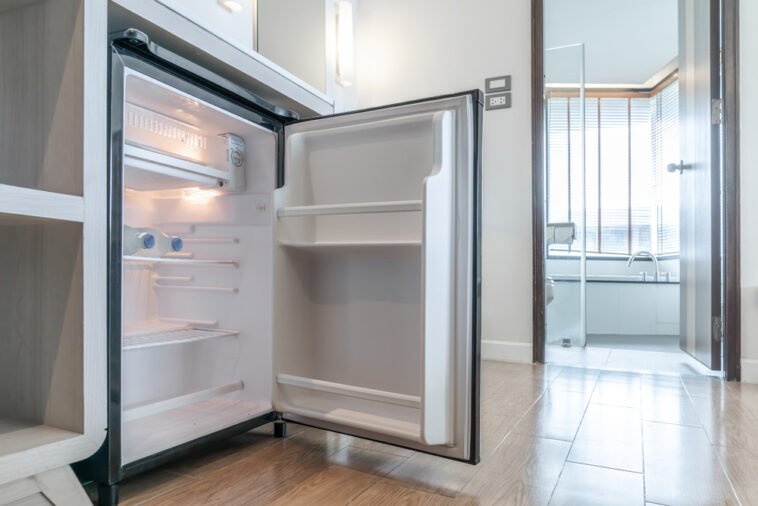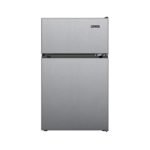Mini Fridger’s energy efficiency can be determined by its Energy Star rating and annual energy consumption, providing insight into its energy-saving capabilities. With a concise two-sentence answer, we can ascertain the energy efficiency of a Mini Fridge by considering factors such as its Energy Star rating and annual energy consumption.

By doing so, we gain a better understanding of the appliance’s energy-saving potential. Now, let’s delve into the topic of Mini Fridger energy efficiency. In today’s fast-paced world, where energy conservation is becoming increasingly important, consumers are seeking appliances that not only perform well but also minimize their impact on the environment and reduce electricity bills.
This also holds true for Mini Fridgers, which are compact refrigerators that offer convenience and versatility in small spaces. However, it’s essential to consider their energy efficiency before making a purchase. This article will explore the various aspects of Mini Fridger’s energy efficiency, including Energy Star ratings, annual energy consumption, and the benefits of choosing an energy-efficient model. By the end, you’ll be equipped with the knowledge to make a well-informed decision when selecting a Mini Fridge.
Understanding Energy Consumption
Mini fridges are popular for those looking to save space and have convenient cold storage options. However, it’s essential to understand the energy consumption of these appliances. You can make informed decisions to maximize energy efficiency by comprehending the basics of how mini-fridges operate.
Mini fridges operate similarly to full-sized refrigerators but on a smaller scale. They typically have a compressor, evaporator, condenser, and refrigerant to cool the compartment. When the temperature inside rises above the set level, the compressor kicks in to regulate it.
The energy consumption of mini fridges can vary depending on factors such as usage patterns. For instance, frequent opening and closing of the fridge door or leaving it open for extended periods increases energy usage. Additionally, the ambient room temperature can impact energy consumption.
| Factors affecting energy efficiency in small appliances |
|---|
| 1. Size and insulation: Smaller fridges tend to be more energy-efficient. Proper insulation helps maintain consistent temperatures and reduce energy loss. |
| 2. Temperature settings: Setting the fridge to the recommended temperature range ensures optimal energy usage. |
| 3. Placement: Placing the mini fridge away from direct sunlight and heat sources prevents unnecessary energy consumption. |
| 4. Maintenance: Regularly cleaning the coils and defrosting the freezer compartment improves energy efficiency. |

Credit: www.amazon.com
Choosing An Energy-efficient Model
Energy efficiency is a key consideration when choosing a mini fridge. An energy-efficient model not only helps reduce electricity consumption but also lowers utility bills in the long run. One important aspect to consider is the Energy Star ratings. The Energy Star label indicates that a product meets certain energy efficiency criteria the Environmental Protection Agency (EPA) set. When you’re browsing for mini-fridges, be sure to read and interpret the energy labels. These labels provide valuable information about the appliance’s energy consumption and efficiency. Take note of the estimated annual energy consumption and compare it across different models to make an informed decision. Additionally, comparing mini fridge brands can also help you find the best energy-efficient option. Look for brands that prioritize energy efficiency and have a track record of producing energy-saving appliances. By considering Energy Star ratings and comparing brands, you can choose a mini fridge that not only meets your needs but also reduces your carbon footprint.
Effective Placement And Installation
The placement and installation of a mini fridge are crucial when aiming for energy efficiency. By strategically choosing the location, you can ensure optimal energy conservation. External temperatures can also have a significant impact on the fridge’s efficiency. Placing the mini fridge away from heat sources such as direct sunlight or hot appliances can help maintain its cool temperature. Adequate ventilation is essential to prevent the buildup of heat and ensure efficient operation.
Installation tips play a significant role in improving the performance of a mini fridge. Ensuring proper insulation, such as sealing gaps and cracks, helps maintain the internal temperature and reduce energy consumption. Additionally, placing the fridge on a level surface allows it to function optimally, minimizing any strain on the internal components. Regularly cleaning the condenser coils and keeping them free from dust and debris can enhance the fridge’s efficiency.
Regular Cleaning And Upkeep
Regular cleaning and upkeep
To ensure optimal energy efficiency of your mini fridge, it is essential to perform regular cleaning and upkeep. This includes cleaning the coils and interior spaces of the fridge. The coils at the back or bottom of the fridge tend to accumulate dust and dirt over time, which can hinder the fridge’s cooling performance. Cleaning the coils can improve the fridge’s overall efficiency and reduce energy consumption.
Another important aspect of maintenance is sealing and insulation maintenance. Check for any cracks or gaps in the door seals and ensure they are tightly sealed. Poorly sealed doors can lead to air leaks, causing the fridge to work harder to maintain its temperature. Maintaining proper insulation is crucial in preventing cool air from escaping and warm air from entering the fridge.
Lastly, consider scheduling professional maintenance checks for your mini fridge. A professional can thoroughly inspect and clean various components, ensuring that your fridge works efficiently and identifying potential issues early on.
Smart Usage Habits
When it comes to enhancing the energy efficiency of your mini fridge, developing smart usage habits is crucial. One of the key habits to adopt is ensuring appropriate internal loading for optimal airflow. By organizing your items to allow for proper air circulation, you can prevent the fridge from working harder than necessary. Additionally, adjusting the temperature settings can greatly impact efficiency. Finding the ideal temperature range for your needs and avoiding excessively cold settings can minimize energy consumption. Power-saving modes and features like sleep mode or auto-defrost can also contribute to energy efficiency. Utilizing these settings can help reduce power consumption when the fridge is not in frequent use. By implementing these smart usage habits, you can maximize the energy efficiency of your mini fridge and minimize both environmental impact and energy costs.
Innovations In Mini Fridge Energy Efficiency
The mini fridge market has seen significant innovations in energy efficiency in recent years. Technological advancements have played a major role in enhancing the energy efficiency of these appliances. Manufacturers are now incorporating features such as variable speed compressors, improved insulation, and advanced control systems, which help in reducing energy consumption.
Future trends in energy-efficient appliances are likely to focus on smart technologies that automatically adjust settings based on usage patterns, as well as the use of environmentally friendly refrigerants. This will not only save energy but also reduce environmental impact.
Legislation and regulations also have a significant impact on appliance efficiency. Governments worldwide are imposing stricter energy standards and labeling requirements, which drive manufacturers to develop more energy-efficient products. These initiatives positively impact the environment and help consumers save on energy bills.
Evaluating Costs And Savings
When considering purchasing a mini fridge, it is important to evaluate the costs and potential savings associated with energy efficiency. Analyzing the cost-benefit of energy-efficient models is crucial in making an informed decision. By estimating the energy savings over time, you can determine if the upfront cost of an energy-efficient mini fridge is worth the long-term investment. Energy-efficient models can help reduce monthly energy consumption and lower electricity bills, saving you money in the long run. Additionally, it’s worth considering incentives and rebates offered for choosing efficient appliances. These incentives can provide further cost savings and make energy-efficient mini-fridges more affordable. By carefully considering the costs and savings associated with energy efficiency, you can make a wise decision that benefits both your wallet and the environment.
Frequently Asked Questions About Mini Fridge Energy Efficiency
Are Mini Fridges Energy Efficient?
Mini fridges are generally energy efficient due to their small size and lower power consumption.
Does A Mini Fridge Increase Electric Bill?
Yes, a mini fridge does increase your electric bill because it needs to run continuously to keep your food and beverages cool.
How Can I Make My Mini Fridge More Energy Efficient?
To make your mini fridge more energy efficient, keep it in a cool area away from heat sources, such as direct sunlight and stoves. Ensure proper ventilation by leaving space around the fridge. Set the temperature to the recommended level and avoid overfilling it.
What Type Of Refrigerator Is Most Energy Efficient?
The Energy Star-certified refrigerators are the most efficient as they consume less energy.
Conclusion
The energy efficiency of mini fridges is a crucial consideration for both cost-conscious individuals and the environmentally conscious. By choosing an energy-efficient mini fridge, you not only save on electricity bills but also contribute to reducing greenhouse gas emissions.
Incorporating features such as adjustable temperature settings and high-quality insulation, these mini fridges provide an optimal cooling experience while minimizing energy consumption. Next time you are shopping for a mini fridge, be sure to prioritize energy efficiency to make the most sustainable choice.


GIPHY App Key not set. Please check settings